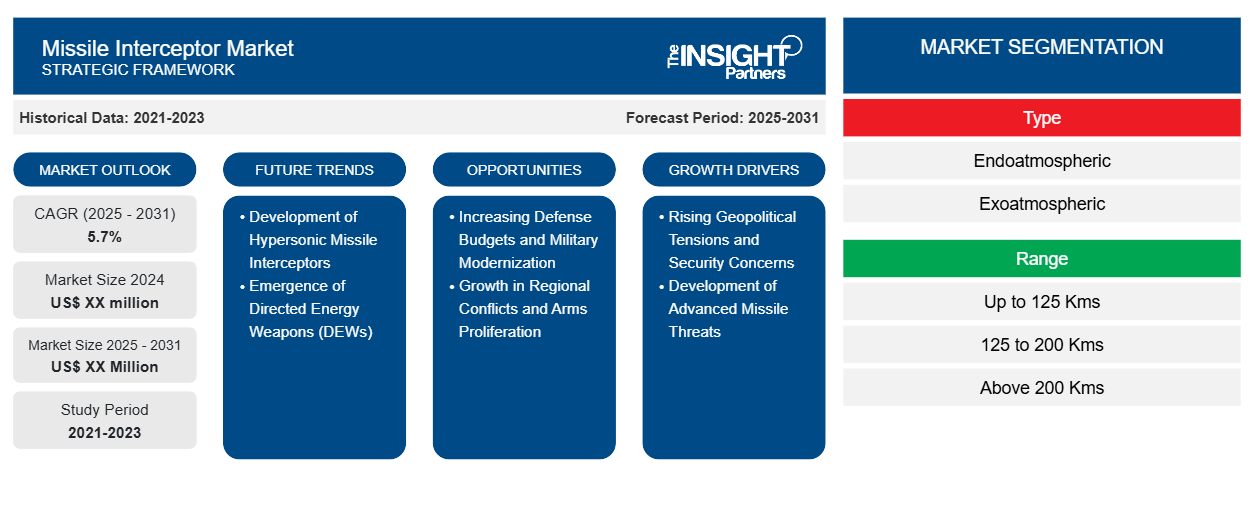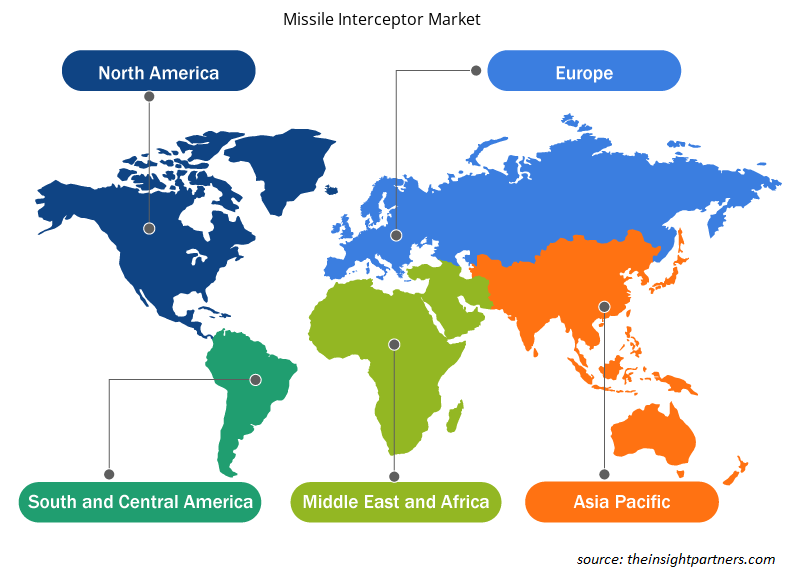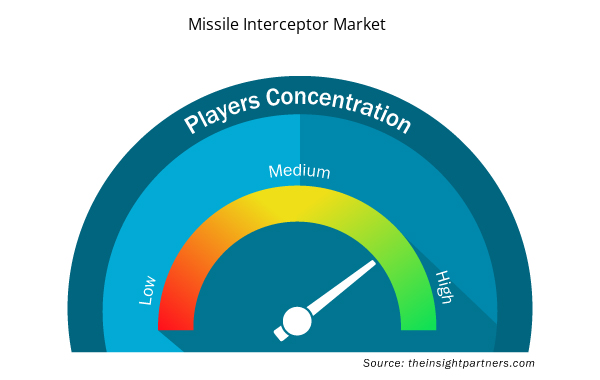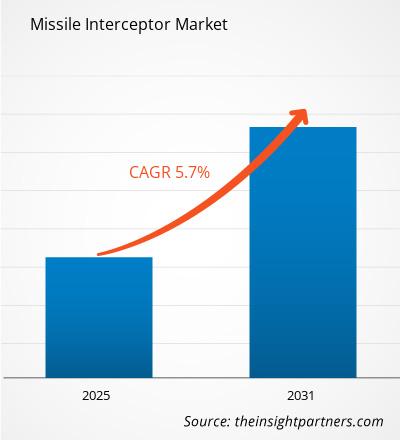The Missile Interceptor Market is expected to register a CAGR of 5.7% from 2025 to 2031, with a market size expanding from US$ XX million in 2024 to US$ XX Million by 2031.
Missile Interceptor Market covers analysis By Type (Endoatmospheric, Exoatmospheric); Range (Up to 125 Kms, 125 to 200 Kms, Above 200 Kms) , and Geography (North America, Europe, Asia Pacific, and Middle East and Africa, South and Central America)
Purpose of the Report
The report Missile Interceptor Market by The Insight Partners aims to describe the present landscape and future growth, top driving factors, challenges, and opportunities. This will provide insights to various business stakeholders, such as:
- Technology Providers/Manufacturers: To understand the evolving market dynamics and know the potential growth opportunities, enabling them to make informed strategic decisions.
- Investors: To conduct a comprehensive trend analysis regarding the market growth rate, market financial projections, and opportunities that exist across the value chain.
- Regulatory bodies: To regulate policies and police activities in the market with the aim of minimizing abuse, preserving investor trust and confidence, and upholding the integrity and stability of the market.
Missile Interceptor Market Segmentation
Type
- Endoatmospheric
- Exoatmospheric
Range
- Up to 125 Kms
- 125 to 200 Kms
- Above 200 Kms
Customize This Report To Suit Your Requirement
You will get customization on any report - free of charge - including parts of this report, or country-level analysis, Excel Data pack, as well as avail great offers and discounts for start-ups & universities
Missile Interceptor Market: Strategic Insights

- Get Top Key Market Trends of this report.This FREE sample will include data analysis, ranging from market trends to estimates and forecasts.
Missile Interceptor Market Growth Drivers
- Rising Geopolitical Tensions and Security Concerns: Geopolitical instability and rising security concerns in many regions are major drivers for the missile interceptor market. Nations across the globe are enhancing their defense capabilities in response to the increasing threat of missile attacks, both from state and non-state actors. The proliferation of missile technology, particularly ballistic missiles and cruise missiles, has led to a growing demand for advanced missile defense systems, including interceptors. Countries in conflict-prone areas or with high defense expenditure, such as the U.S., Russia, China, India, and Middle Eastern nations, are investing heavily in missile defense systems to protect critical infrastructure, military bases, and civilian populations from missile threats. This growing need for advanced interception capabilities is a primary factor propelling the missile interceptor market.
- Development of Advanced Missile Threats: The continuous development of more sophisticated and accurate missile systems, including hypersonic missiles, has escalated the need for cutting-edge missile interceptor technologies. Hypersonic missiles, in particular, are designed to travel at speeds greater than Mach 5, making them extremely difficult to intercept with traditional defense systems. This poses a significant challenge to existing missile defense strategies, leading to increased investments in advanced interceptor systems capable of defending against these high-speed, evasive threats. The growing complexity and variety of missile threats, including ballistic, cruise, and hypersonic missiles, is driving the innovation of more effective and agile interceptor systems, thereby fueling the growth of the missile interceptor market.
Missile Interceptor Market Future Trends
- Development of Hypersonic Missile Interceptors: As hypersonic missile technology advances, the demand for interceptors capable of defending against these extremely fast-moving, maneuverable threats is expected to skyrocket. Hypersonic missiles pose significant challenges for current missile defense systems due to their high speed and low altitude flight path. The development of hypersonic missile interceptors that can counteract these fast-moving and unpredictable threats is a major focus for defense organizations worldwide. This includes research into novel intercept technologies, such as advanced kinetic kill vehicles and laser-based interceptors, to effectively neutralize hypersonic missiles. The pursuit of such technologies will open up new market opportunities in the missile interceptor space, particularly for companies at the cutting edge of missile defense innovation.
- Emergence of Directed Energy Weapons (DEWs): Directed Energy Weapons (DEWs), such as high-energy lasers and microwave weapons, are increasingly being considered as viable solutions for missile interception. DEWs offer the potential for extremely fast, precise, and cost-effective missile defense, as they can engage multiple targets with minimal logistical effort compared to traditional missile interceptors. By focusing a concentrated beam of energy onto an incoming missile, DEWs can damage or destroy it at a distance, offering a next-generation solution for missile defense. While DEWs are still under development and require extensive testing, they represent a significant future trend in missile interception and could become an integral part of future missile defense systems.
Missile Interceptor Market Opportunities
- Increasing Defense Budgets and Military Modernization: Countries worldwide are increasing their defense budgets, with a particular emphasis on modernizing military capabilities to address evolving threats. This trend is particularly evident in major military powers, such as the United States, China, India, and Russia, where governments are allocating significant resources to develop and deploy advanced missile defense systems, including interceptors. As part of modernization efforts, many countries are replacing aging missile defense systems with more advanced technologies that offer greater interception accuracy, faster response times, and a broader defense range. Additionally, missile interceptors are being integrated into multi-layered defense systems, such as the U.S. Ground-based Midcourse Defense (GMD), Israel's Iron Dome, and India's Advanced Air Defence (AAD) system. These modernization initiatives are expected to drive continuous demand for next-generation missile interceptors.
- Growth in Regional Conflicts and Arms Proliferation: The ongoing conflicts in regions like the Middle East, South Asia, and Eastern Europe are pushing nations to enhance their missile defense capabilities. As tensions rise, especially in areas like the Korean Peninsula, the South China Sea, and Eastern Europe, there is an increasing need for countries to build up their defense infrastructure, including missile interceptors, to ensure national security. The proliferation of missile technology to regional players and non-state actors further exacerbates the need for robust interception systems. In particular, the deployment of long-range missiles in regions such as North Korea, Iran, and other nations poses a direct threat to neighboring countries and global security. This geopolitical uncertainty and the growing risk of missile attacks have created a strong demand for missile interceptors as part of national defense strategies.
Missile Interceptor Market Regional Insights
The regional trends and factors influencing the Missile Interceptor Market throughout the forecast period have been thoroughly explained by the analysts at Insight Partners. This section also discusses Missile Interceptor Market segments and geography across North America, Europe, Asia Pacific, Middle East and Africa, and South and Central America.

- Get the Regional Specific Data for Missile Interceptor Market
Missile Interceptor Market Report Scope
| Report Attribute | Details |
|---|---|
| Market size in 2024 | US$ XX million |
| Market Size by 2031 | US$ XX Million |
| Global CAGR (2025 - 2031) | 5.7% |
| Historical Data | 2021-2023 |
| Forecast period | 2025-2031 |
| Segments Covered |
By Type
|
| Regions and Countries Covered | North America
|
| Market leaders and key company profiles |
Missile Interceptor Market Players Density: Understanding Its Impact on Business Dynamics
The Missile Interceptor Market market is growing rapidly, driven by increasing end-user demand due to factors such as evolving consumer preferences, technological advancements, and greater awareness of the product's benefits. As demand rises, businesses are expanding their offerings, innovating to meet consumer needs, and capitalizing on emerging trends, which further fuels market growth.
Market players density refers to the distribution of firms or companies operating within a particular market or industry. It indicates how many competitors (market players) are present in a given market space relative to its size or total market value.
Major Companies operating in the Missile Interceptor Market are:
- Aerojet Rocketdyne
- BAE Systems, Inc.
- Boeing
- Israel Aerospace Industries
- Lockheed Martin Corporation
Disclaimer: The companies listed above are not ranked in any particular order.

- Get the Missile Interceptor Market top key players overview
Key Selling Points
- Comprehensive Coverage: The report comprehensively covers the analysis of products, services, types, and end users of the Missile Interceptor Market, providing a holistic landscape.
- Expert Analysis: The report is compiled based on the in-depth understanding of industry experts and analysts.
- Up-to-date Information: The report assures business relevance due to its coverage of recent information and data trends.
- Customization Options: This report can be customized to cater to specific client requirements and suit the business strategies aptly.
The research report on the Missile Interceptor Market can, therefore, help spearhead the trail of decoding and understanding the industry scenario and growth prospects. Although there can be a few valid concerns, the overall benefits of this report tend to outweigh the disadvantages.
- Historical Analysis (2 Years), Base Year, Forecast (7 Years) with CAGR
- PEST and SWOT Analysis
- Market Size Value / Volume - Global, Regional, Country
- Industry and Competitive Landscape
- Excel Dataset


- Nuclear Decommissioning Services Market
- Space Situational Awareness (SSA) Market
- Visualization and 3D Rendering Software Market
- Frozen Potato Market
- Identity Verification Market
- Lymphedema Treatment Market
- Digital Pathology Market
- Glycomics Market
- Parking Management Market
- Aircraft Wire and Cable Market

Report Coverage
Revenue forecast, Company Analysis, Industry landscape, Growth factors, and Trends

Segment Covered
This text is related
to segments covered.

Regional Scope
North America, Europe, Asia Pacific, Middle East & Africa, South & Central America

Country Scope
This text is related
to country scope.
Frequently Asked Questions
Some of the customization options available based on the request are an additional 3-5 company profiles and country-specific analysis of 3-5 countries of your choice. Customizations are to be requested/discussed before making final order confirmation, as our team would review the same and check the feasibility.
The report can be delivered in PDF/PPT format; we can also share excel dataset based on the request.
The major players in the market includes BAE Systems, Bharat Dynamics, China Aerospace Science and Industry Corporation, Denel Dynamics, General Dynamics, Hanwha, Israel Aerospace Industries, Kongsberg Defence & Aerospace, L3Harris Technologies, Lockheed Martin, MBDA, Mitsubishi Heavy Industries,Northrop Grumman, Rafael Advanced Defense Systems, Raytheon Technologies, Roketsan
The Missile Interceptor Market is estimated to witness a CAGR of 5.7% from 2023 to 2031
Complex design of the missile interceptors hinders the market growth.
Trends and growth analysis reports related to Aerospace and Defense : READ MORE..
1. Aerojet Rocketdyne
2. BAE Systems, Inc.
3. Boeing
4. Israel Aerospace Industries
5. Lockheed Martin Corporation
6. MBDA
7. Northrop Grumman
8. Rafael Advanced Defense Systems Ltd.
9. Raytheon Technologies
10. Thales Group

 Get Free Sample For
Get Free Sample For